The
History of the Transformer
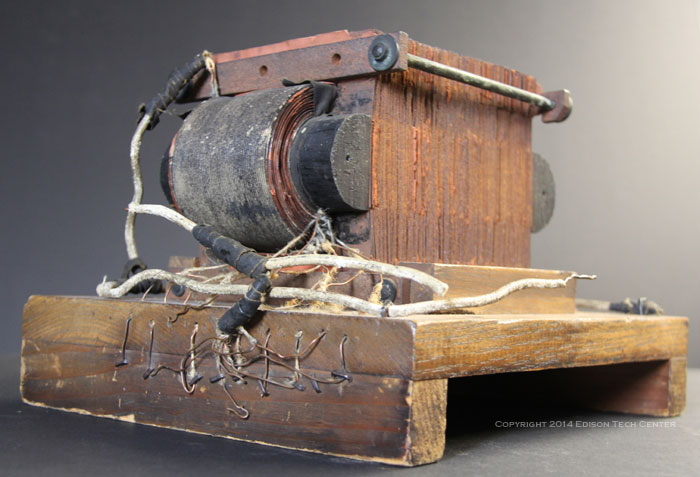
The
original 1885 Stanley prototype transformer at the Berkshire
Museum.
1. About Transformers
2. Timeline of Transformer Development
3. The Problem of Transmitting Power (transformers and their role)
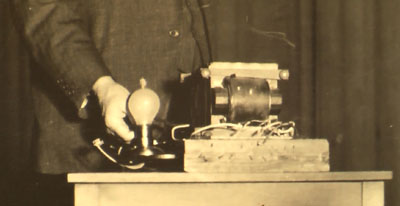 |
"the
heart of the alternating current system"
-
William Stanley Jr.
|
E.W.
Rice Jr.(2nd president of General Electric) powers a lightbulb
using
William Stanley's original 1885 transformer |
|
What
is a Transformer?
A: A transformer is is a device that transfers electrical energy from
one circuit to another through inductively coupled conductors—the
transformer's coils.
Video:
Lionel Barthold, pioneer in power transmission describes how a transformer
works
How
is it used? A: A transformer is used to bring voltage up
or down in an AC electrical circuit. A transformer can be used to
convert AC power to DC power. There are transformers all over every
house, they are inside the black plastic case which you plug into
the wall to recharge your cell phone or other devices. These types
are often called "wall warts". They can be very large, as
in national utility systems, or it can be very small embedded inside
electronics. It is an essential part of all electronics today.
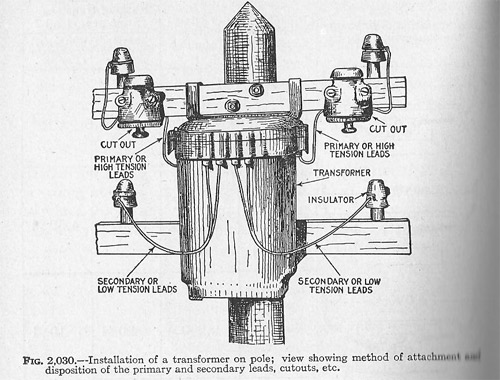
|
|
|
|
|
William
Stanley (USA)
|
Lucien
Gaulard (France)
|
Sebastian
Ziani de Ferranti (England)
|
Who
invented the transformer? Ottó Bláthy,
Miksa Déri, Károly
Zipernowsky of the Austro-Hungarian Empire
First designed and used the transformer in both experimental, and
commercial systems. Later on Lucien
Gaulard, Sebstian
Ferranti, and William Stanley
perfected the design. See the next question for more details.
When
was the transformer invented? A: The property of induction
was discovered in the 1830's but it wasn't until 1886 that William
Stanley, working for Westinghouse built the first reliable
commercial transformer. His work was built upon some rudimentary designs
by the Ganz Company in Hungary (ZBD Transformer 1878), and Lucien
Gaulard and John Dixon Gibbs in England. Nikola Tesla did not invent
the transformer as some dubious sources have claimed. The Europeans
mentioned above did the first work in the field. George Westinghouse,
Albert Schmid, Oliver Shallenberger and Stanley made the transformer
cheap to produce, and easy to adjust for final use.
|
1885
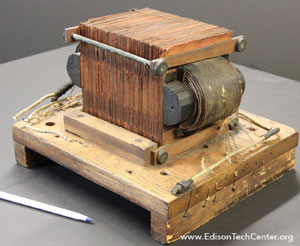
William Stanley's
First Transformer built in 1885. Single phase AC power.
|
1886
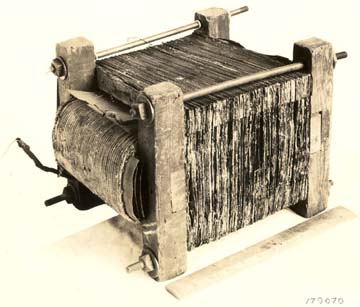
|
Where
were the first transformers used? The first AC power system
that used the modern transformer was in Great Barrington, Massachusetts
in 1886. Earlier forms of the transformer were used in Austro-Hungary
1878-1880s and 1882 onward in England. Lucien Gaulard (Frenchman)
used his AC system for the revolutionary Lanzo to Turin electrical
exposition in 1884 (Northern Italy). In 1891 mastermind Mikhail Dobrovsky
designed and demonstrated his 3 phase transformers in the Electro-Technical
Exposition at Frankfurt, Germany.
Click on the link below to learn about the Great Barrington Electrification:

Varieties of Transformers
There are many types of transformers with different designs used for all
kinds of applications from radio to microelectronics. See our video below which talks about
types of transformers and their core material iron:
Above left: toroidal transformer / Above right: High frequency choke transformer core
Learn more about the material engineering and importance of IRON.
2. Transformer
development timeline:
|
1830s
- Joseph Henry and Michael Faraday work with electromagnets and discover
the property of induction independently on separate continents.
1836
- Rev. Nicholas Callan of Maynooth College, Ireland invents the
induction coil
1876
- Pavel Yablochkov uses induction coils in his lighting system
1878 -1883 - The Ganz Company
(Budapest, Hungary) uses induction coils in their lighting systems
with AC incandescent systems. This is the first appearance and use
of the toroidal shaped transformer.
1881 - Charles F. Brush
of the Brush Electric
Company in Cleveland, Ohio develops his own design of transformer
(source: Brush Transformers Inc.)
 |
1880-1882
- Sebastian Ziani de Ferranti (English born with an
Italian parent) designs one of the earliest AC power systems
with William Thomson (Lord Kelvin). He creates an early
transformer. Gaulard and Gibbs later design a similar transformer
and loose the patent suit in English court to Ferranti.
|
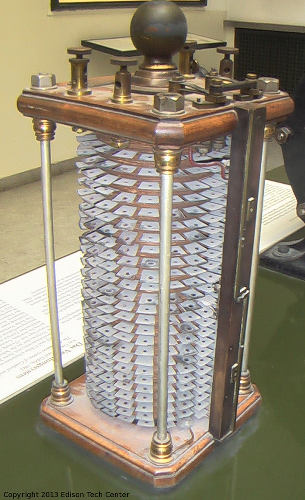 1882
- Lucien Gaulard and John Dixon Gibbs first built a "secondary
generator" or in today's terminology a step down transformer
which they designed with open iron core, the invention was not very
efficient to produce. It had a linear shape which did not work efficiently.
It was first used in a public exhibition in
Italy in 1884 where the transformer brought down high voltage
for use to light incandescent and arc lights. Later they designed
a step up transformer. Gaulard (French) was the engineer and Gibbs
(English) was the businessman behind the initiative. They sold the
patents to Westinghouse. Later they lost rights to the patent when
Ferranti (also from England) took them to court.
1882
- Lucien Gaulard and John Dixon Gibbs first built a "secondary
generator" or in today's terminology a step down transformer
which they designed with open iron core, the invention was not very
efficient to produce. It had a linear shape which did not work efficiently.
It was first used in a public exhibition in
Italy in 1884 where the transformer brought down high voltage
for use to light incandescent and arc lights. Later they designed
a step up transformer. Gaulard (French) was the engineer and Gibbs
(English) was the businessman behind the initiative. They sold the
patents to Westinghouse. Later they lost rights to the patent when
Ferranti (also from England) took them to court.

Ottó Bláthy,
Miksa Déri, Károly
Zipernowsky created the "Z.B.D Transformer"
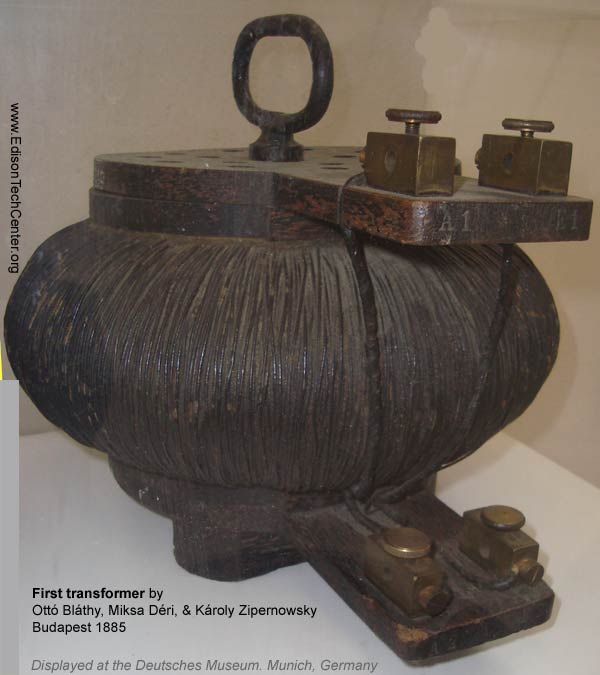
1884
- In Hungary Ottó Bláthy had suggested the use
of closed-cores, Károly Zipernowsky the use of shunt
connections, and Miksa Déri had performed the experiments.
They found the major flaw of the Gaulard-Gibbs system were successful
in making a high voltage circuit work using transformers in parallel.
There design was a
toroidal shape which made it expensive to make. Wires could not be
easily wrapped around it by machine during the manufacturing process.
1884 - Use of Lucien Gaulard's
transformer system (a series system) in the first large exposition
of AC power in Turin, Italy. This event caught the eye of William
Stanley, working for Westinghouse. Westinghouse bought rights to the
Gaulard and Gibbs Transformer design. The 25 mile long transmission
line illuminated arc lights, incandescent lights, and powered a railway.
Gaulard won an award from the Italian government of 10,000 francs.
1885
- George Westinghouse orders a Siemens alternator (AC generator)
and a Gaulard and Gibbs transformer. Stanley begin experimenting with
this system.
1885 - William
Stanley makes the transformer more practical due to some design
changes: "Stanley's first patented design was for induction coils
with single cores of soft iron and adjustable gaps to regulate the
EMF present in the secondary winding. This design was first used commercially
in the USA in 1886". William Stanley explains to Franklin
L. Pope (advisor to Westinghouse and patent lawyer) that
is design was salable and a great improvement. Pope disagrees but
Westinghouse decides to trust Stanley anyway.
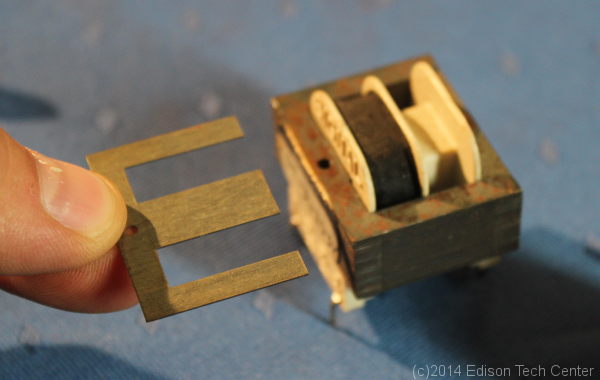
Above: the modern E-core transformer is based on Stanley's design. Iron
plates stamped in an E shape can be inserted from both sides of the winding.
George
Westinghouse and William Stanley create a transformer that is
practical to produce (easy to machine and wind in a square shape,
making a core of E shaped plates) and comes in both step up and step
down variations. George Westinghouse understood that to make AC power
systems successful the Gaulard design had to be changed. The toroidal
transformer used by the Ganz Company in Hungary and Gibbs in England
were very expensive to produce (there was no easy way to wind wire
around an iron ring without hand labor).
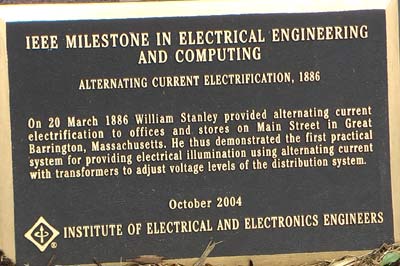
1886
- William Stanley uses his transformers in the electrification of
downtown Great Barrington, MA.This
was the first demonstration of a full AC power distribution system
using step and step down transformers.
Later 1880s
- Later on Albert Schmid improved Stanley's design, extending
the E shaped plates to meet a central projection.
1889
- Russian-born engineer Mikhail
Dolivo-Dobrovolsky developed the first three-phase transformer
in Germany at AEG. He had developed the first three phase generator
one year before. Dobrovolsky used his transformer in the first powerful
complete AC system (Alternator + Transformer + Transmission + Transformer
+ Electric Motors and Lamps) in 1891.
|
|
1891
Early three phase transformer (circular core type)
Siemens and Halske company
5.7 kVA 1000/100 V
This transformer was created at the beginning of the modern
electrical grid, the same year as the Frankfurt Electrical
Exhibition which demonstrated long distance transmission of
power.
The artifact in
this photo is on display at the Deutsches Museum:
www.deutsches-museum.de
|
1880s
- today - Transformers are improved by increasing efficiency,
reducing size, and increasing capacity.
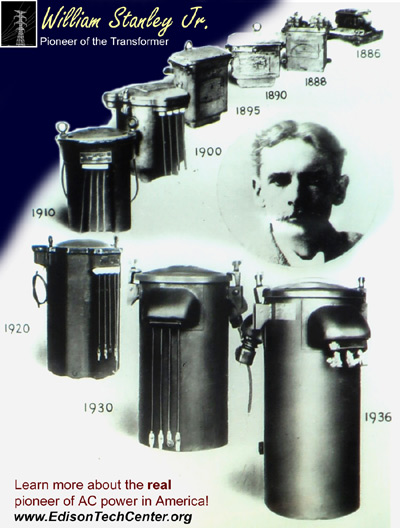 |
The graphic to
the left shows the progression and advancement of the transformer
over the years.
William Stanley once wrote: " I have a very personal
affection for a transformer." "It is such a complete
and simple solution for a difficult problem. It so puts to
shame all mechanical attempts at regulation. It handles with
such ease, certainty, and economy vast loads of energy that
are instantly given to or taken from it. It is so reliable,
strong, and certain."
|
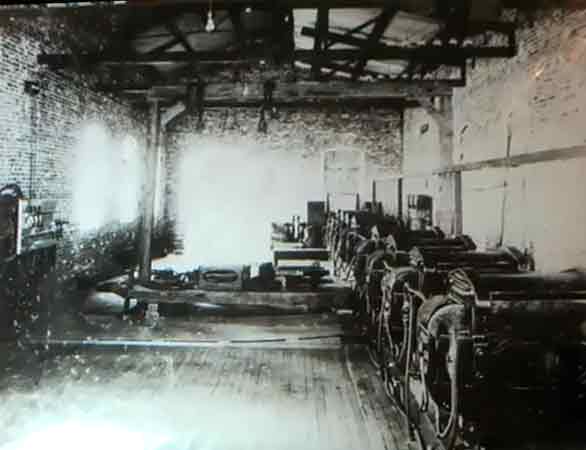
1895 Air
cooled transformers built by William Stanley for a three phase AC
power station

Large Westinghouse
transformers from 1917 at the Hydropower plant
at Folsom, California.
Electricity
Explained:
3. The Problem of Transmitting
Power:
DC
power was mainly in used in the 1880's and it was hard
to transmit over distance because:
-To transmit over long distance you need high voltage
on a skinny wire or low voltage on a wide wire.
High voltage on DC is very dangerous, and with low voltage
the wire would have to be so thick that it would not be practical.
Also with high voltage you couldn't not step down the voltage
so it could be used with home light bulbs.
Using
the water analogy: imagine that a small wire with high
voltage is like a garden hose with high pressured water moving
fast inside. Imagine that this hose fills 2 gallon jugs of
water in one minute. Now think of a 6" wide drain pipe
filled with water. You can deliver the same amount of water
to the destination in the same time period without needing
so much pressure.
With AC power you also use high voltage to move the
electricity down a long wire. AC becomes more practical because
once you send the power to the destination, you can use a
transformer to change the voltage down to a manageable level.
The power is stepped down several times by the time it reaches
you home. The power line coming into your home is at 240 volts,
from your breaker box it is split into lines of 120 volts
for most of your home sockets and 240 for appliance sockets.
In Europe and other regions 220 V is the standard home socket.
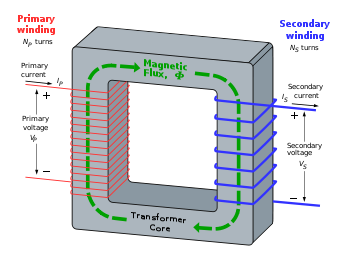
Transformer
- a device that transfers electrical energy from one circuit
to another circuit using inductively coupled conductors. In
other words by putting two coils of wire close together while
not touching, the magnetic field from the first coil called
the primary winding effects the other coil (called
the secondary coil). This effect is called "inductance".
Inductance was discovered by Joseph
Henry and Michael Faraday in 1831.
Now if you would like to change the voltage on a powerline,
you could do this by changing current going into the primary
coil (voltage stays high). The current level affects the induced
voltage on the secondary coil. A changing magnetic field induces
a changing electromagnetic force (EMF) or "voltage".
To put it simply: by changing the current you can obtain the
desired voltage on the other side.
Below: small transformer used for consumer electronics:

Below: large transformer used for residential power service

Learn more about Power Transmission:
by M. Whelan,
Steve Rockwell and additional research by Steve Normandin
Sources:
-Brush Transformers.
http://www.brushtransformers.com/about-us/history
-Deutsches Museum, Munich, Germany
-Wikipedia, Transformers
-Wikipedia, Sebastian Ferranti, Lucien Gaulard
-Fifty Sites in Great Barrington, Massachusetts Associated with William
Stanely. Great Barrington Land Conservancy, Great Barrington Historical
Society. 2006
-The
Power Makers: Steam, Electricity, and the Men Who Invented Modern
America by Maury Klein.
2009
-How a Transformer Works,
interview with Lionel Barthold. Video. Edison Tech Center.
-Tom Blalock - Historian
-The Berkshire Museum, Pittsfield, MA
-Alternating Current Development in America, by William Stanley. 1912
Photos:
Edison Tech Center
Folsom Power House Archives
Schenectady Museum
Whelan Communications
|

